Reactive Power Optimal Control of a Wind Farm for Minimizing Collector System Losses
Abstract
:1. Introduction
2. The Proposed Reactive Power Control System
2.1. Sensitivity Coefficient Matrix
2.2. Objective Functions
2.3. Constraints
3. Algorithm to Solve the Model
3.1. Genetic Algorithm
3.2. Particle Swarm Optimization Algorithm
3.3. Constraints Handling
- --
- indicates the control variables involving the reactive power setting of all WTs.
- --
- represents the dependent variables, including all bus voltages and the reference reactive power of the PCC.
- --
- , and are called the penalty factors in this study; they increase gradually and have little influence on the initial iterations.
- --
- is the absolute value of the difference between and .
4. Case Study
4.1. Wind Farm Model Description
4.2. Case 1: V = 9 m/s,
4.3. Case 2: V = 9 m/s,
4.4. Total Annual Losses in the WF
4.5. Environmental Indicators Analysis
5. Conclusions
- Combining the reactive power/voltage control with the loss reduction control of the collector system reduces the operating loss of the WF effectively; this is verified by a simulation based on an actual wind farm.
- Both the GA and PSO optimization methods designed in this paper can reduce the operating loss effectively but the GA has a better performance of energy savings with regard to the annual loss in this case.
- The control strategy proposed in this paper would be used to improve the automatic control level, reduce the cost of electricity production, and improve the energy savings under various operating conditions of a WF, which has good application prospects.
Author Contributions
Acknowledgments
Conflicts of Interest
Appendix A
| Parameter | 5 MW NERL Wind Turbine |
|---|---|
| Cut-in, Rated, Cut-out Wind Velocity | 3 m/s, 11.4 m/s, 25 m/s |
| Rotor, Hub Diameter | 126 m, 3 m |
| Rated Power | 5 MW |
| Cut-in, Rated Rotor Velocity | 6.9 rpm, 12.1 rpm |
| Gearbox Ratio | 97:1 |
| Cable Types | Cross Section (mm2) | Specific Resistance (Ω/km) | Specific Capacitance (μF/km) | Specific Inductance (μH/km) |
|---|---|---|---|---|
| Type 1 | 95 | 0.1842 | 0.18 | 0.44 |
| Type 2 | 150 | 0.1167 | 0.21 | 0.41 |
| Type 3 | 240 | 0.0729 | 0.24 | 0.38 |
References
- National Grid plc. The Grid Code (Issue 5, Revision 13). Available online: http://www.nationalgrid.com/uk (accessed on 2 June 2018).
- Qiao, W.; Harley, R.G.; Venayagamoorthy, G.K. Coordinated reactive power control of a large wind farm and a STATCOM using heuristic dynamic programming. IEEE Trans. Energy Convers. 2009, 24, 493–503. [Google Scholar] [CrossRef]
- El Moursi, M.S.; Bak-Jensen, B.; Abdel-Rahman, M.H. Coordinated voltage control scheme for SEIG-based wind park utilizing substation STATCOM and ULTC transformer. IEEE Trans. Sustain. Energy 2011, 2, 246–255. [Google Scholar] [CrossRef]
- Kumar, V.S.S.; Reddy, K.K.; Thukaram, D. Coordination of reactive power in grid-connected wind farms for voltage stability enhancement. IEEE Trans. Power Syst. 2014, 29, 2381–2390. [Google Scholar] [CrossRef]
- Khatua, K; Yadav, N. Voltage stability enhancement using VSC-OPF including wind farms based on Genetic algorithm. Int. J. Electr. Power Energy Syst. 2015, 73, 560–567. [Google Scholar] [CrossRef]
- Guo, W.T.; Liu, F.; Si, J.N.; He, D.W.; Harley, R.; Mei, S.W. Approximate dynamic programming based supplementary reactive power control for DFIG wind farm to enhance power system stability. Neurocomputing 2015, 170, 417–427. [Google Scholar] [CrossRef]
- Ni, K.; Hu, Y.H.; Liu, Y.; Gan, C. Performance analysis of a four-switch three-phase grid-side converter with modulation simplification in a doubly-fed induction generator-based wind turbine (DFIG-WT) with different external disturbances. Energies 2017, 10, 706. [Google Scholar] [CrossRef]
- Jung, S.; Jang, G. A loss minimization method on a reactive power supply process for wind farm. IEEE Trans. Power Syst. 2017, 32, 3060–3068. [Google Scholar] [CrossRef]
- Wijethunga, A.H.; Ekanayake, J.B.; Wijayakulasooriya, J.V. Collector cable design based on dynamic line rating for wind energy applications. J. Natl Sci. Found. Sri Lanka 2018, 46, 31–40. [Google Scholar] [CrossRef]
- Gong, Y.Z.; Chung, C.Y.; Mall, R.S. Power system operational adequacy evaluation with wind power ramp limits. IEEE Trans. Power Syst. 2018, 33, 2706–2716. [Google Scholar] [CrossRef]
- Wang, D.; Hu, Q.E.; Tang, J.; Jia, H.J.; Li, Y.; Gao, S.; Fan, M.H. A kriging model based optimization of active distribution networks considering loss reduction and voltage profile improvement. Energies 2017, 10, 2162. [Google Scholar] [CrossRef]
- Guo, Q.L.; Sun, H.B.; Wang, B.; Zhang, B.M.; Wu, W.C.; Tang, L. Hierarchical automatic voltage control for integration of large-scale wind power: Design and implementation. Electr. Power Syst. Res. 2015, 120, 234–241. [Google Scholar] [CrossRef]
- Adebayo, I.; Sun, Y.X. New performance indices for voltage stability analysis in a power system. Energies 2017, 10, 2042. [Google Scholar] [CrossRef]
- Wei, S.R.; Zhang, L.; Xu, Y.; Fu, Y.; Li, F.X. Hierarchical optimization for the double-sided ring structure of the collector system planning of large offshore wind farms. IEEE Trans. Sustain. Energy 2017, 8, 1029–1039. [Google Scholar] [CrossRef]
- Zhang, B.H.; Hou, P.; Hu, W.H.; Soltani, M.; Chen, C.; Chen, Z. A reactive power dispatch strategy with loss minimization for a DFIG-based wind farm. IEEE Trans. Sustain. Energy 2016, 7, 914–923. [Google Scholar] [CrossRef]
- Meegahapola, L.; Durairaj, S.; Flynn, D.; Fox, B. Coordinated utilisation of wind farm reactive power capability for system loss optimisation. Int. Trans. Electr. Energy Syst. 2011, 21, 40–51. [Google Scholar] [CrossRef]
- Abdelsalam, A.M.; El-Shorbagy, M.A. Optimization of wind turbines siting in a wind farm using genetic algorithm based local search. Renew. Energy 2018, 123, 748–755. [Google Scholar] [CrossRef]
- Devaraj, D.; Roselyn, J.P. Genetic algorithm based reactive power dispatch for voltage stability improvement. Int. J. Electr. Power Energy Syst. 2010, 32, 1151–1156. [Google Scholar] [CrossRef]
- Amini, M.H.; Moghaddam, M.P.; Karabasoglu, O. Simultaneous allocation of electric vehicles’ parking lots and distributed renewable resources in smart power distribution networks. Sustain. Cities Soc. 2017, 28, 332–342. [Google Scholar] [CrossRef]
- Tahir, M.; Nassar, M.E.; El-Shatshat, R.; Salama, M.M.A. A review of volt/var control techniques in passive and active power distribution networks. IEEE Smart Energy Grid Eng. 2016, 57–63. [Google Scholar] [CrossRef]
- Han, X.J.; Zhang, H.; Yu, X.L.; Wang, L.N. Economic evaluation of grid-connected micro-grid system with photovoltaic and energy storage under different investment and financing models. Appl. Energy 2016, 184, 103–118. [Google Scholar] [CrossRef]
- Yu, S.W.; Zhang, J.J.; Cheng, J.H. Carbon reduction cost estimating of Chinese coal-fired power generation units: A perspective from national energy consumption standard. J. Clean. Prod. 2016, 139, 612–621. [Google Scholar] [CrossRef]
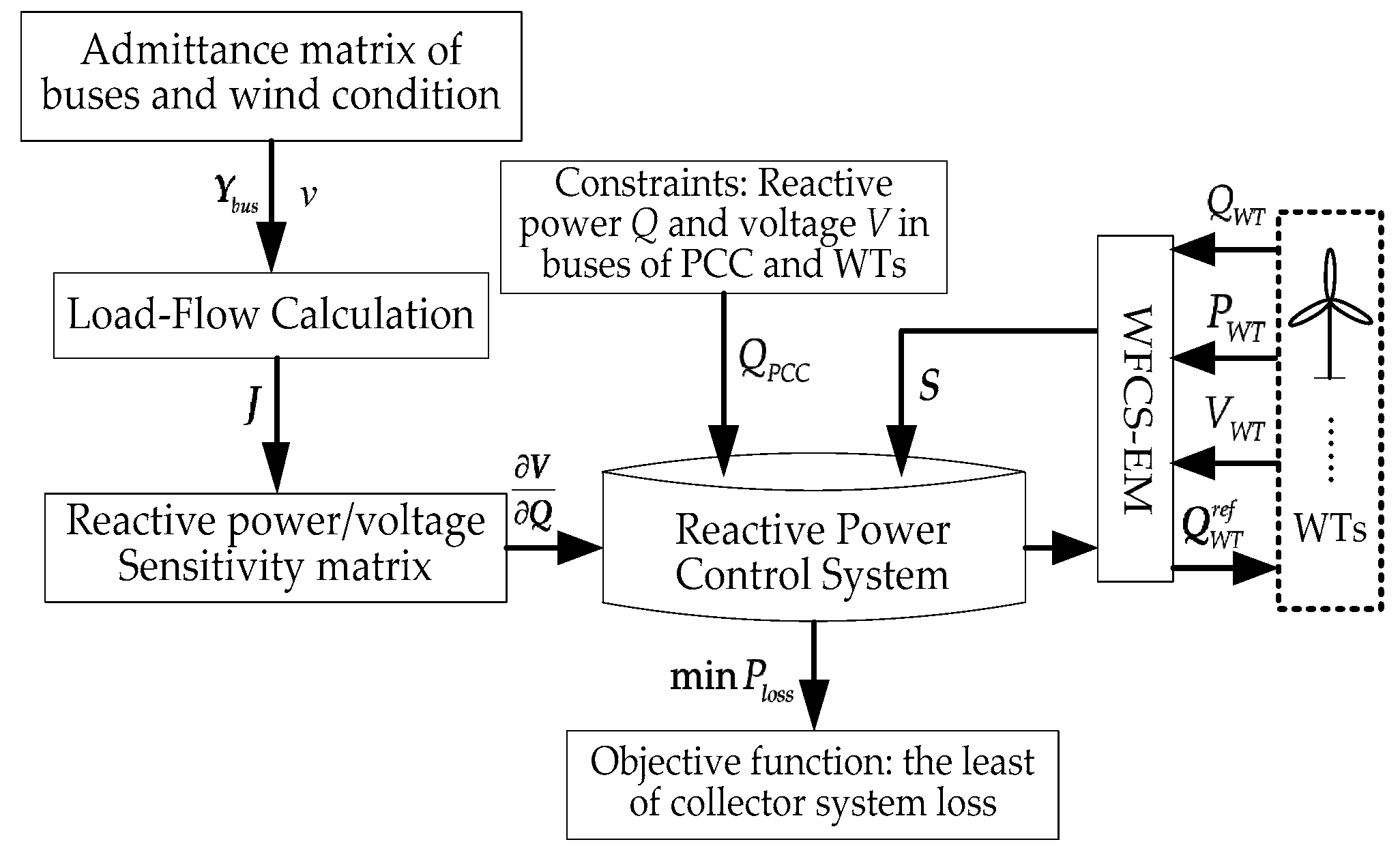
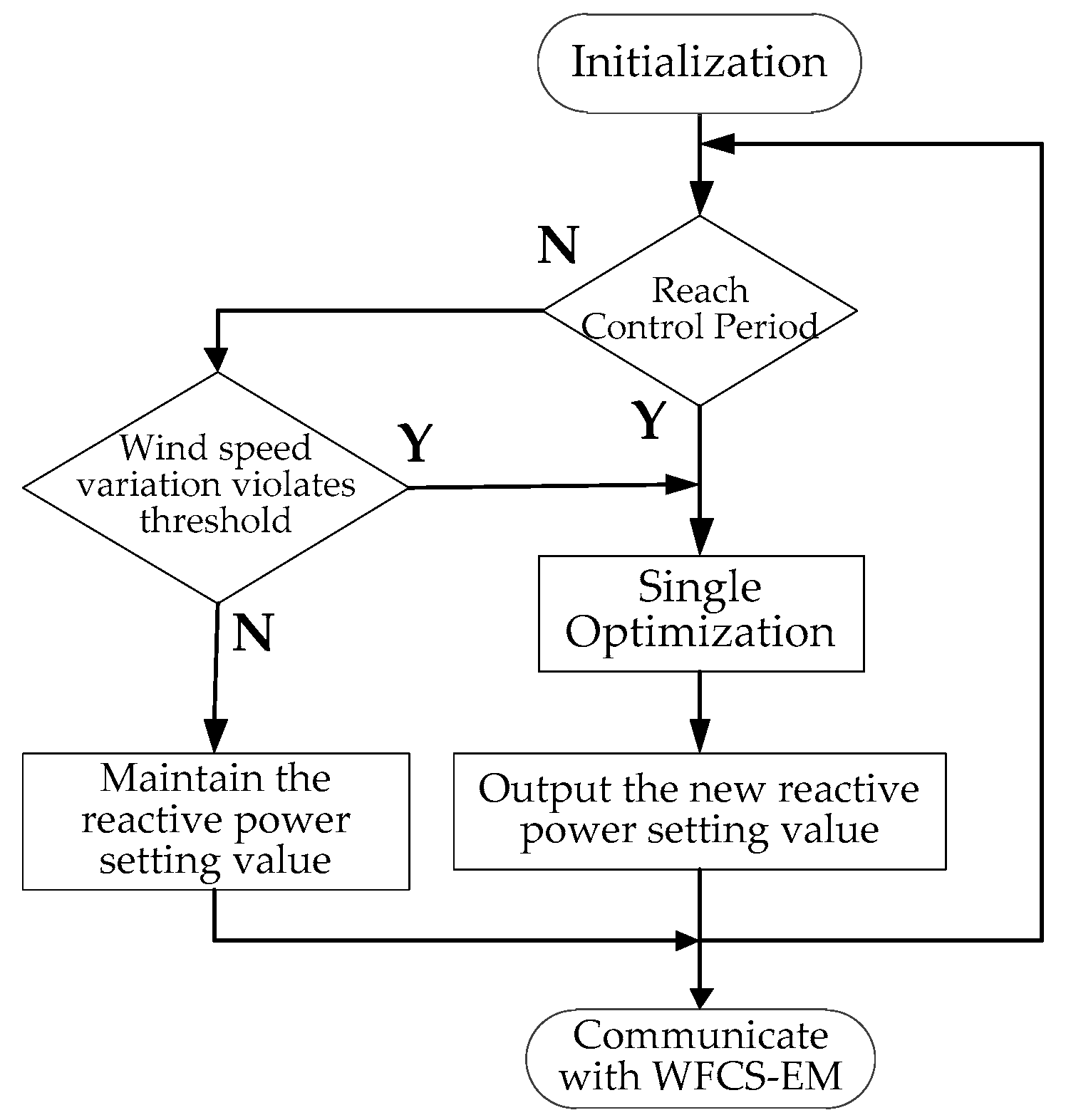
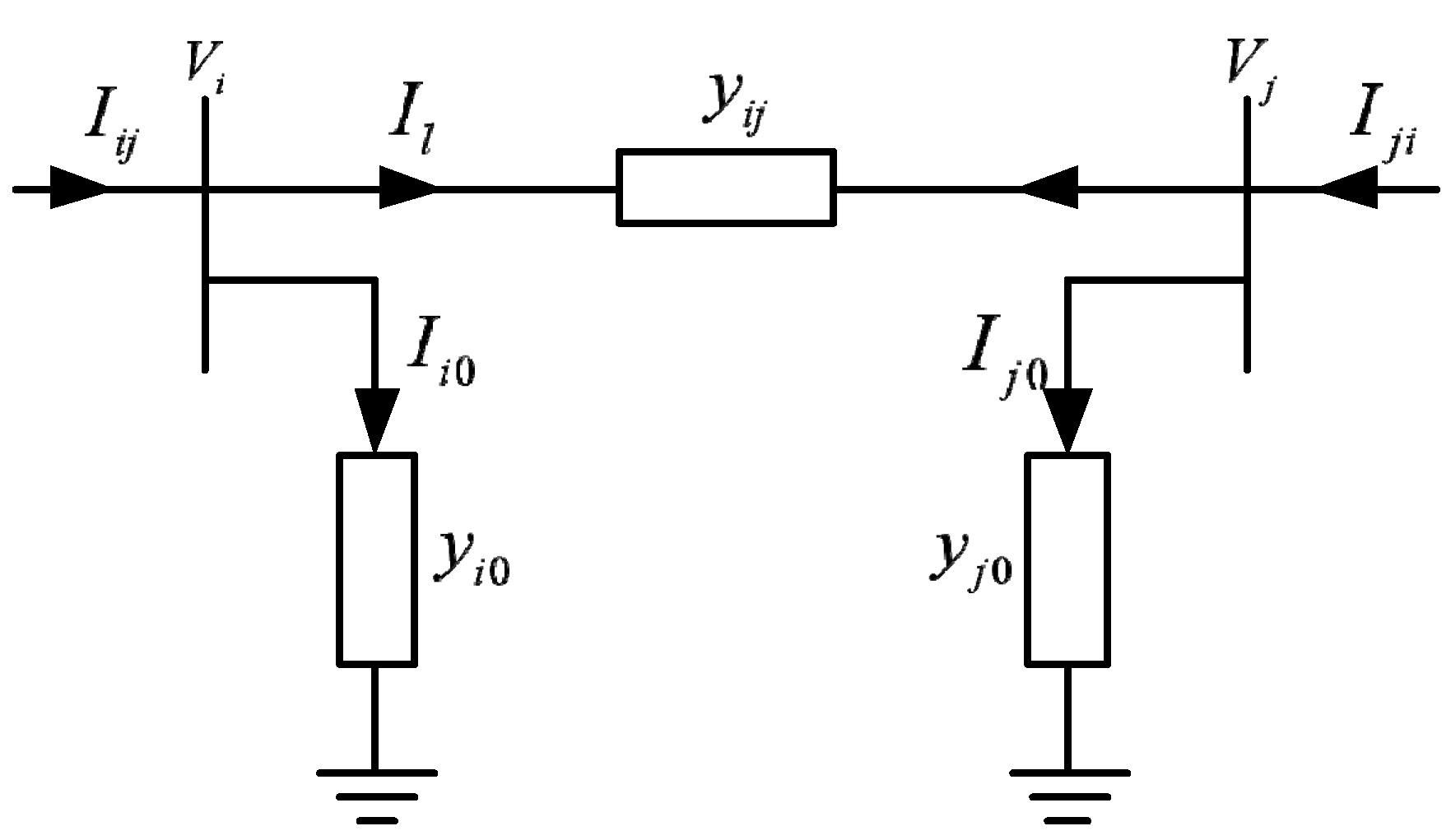


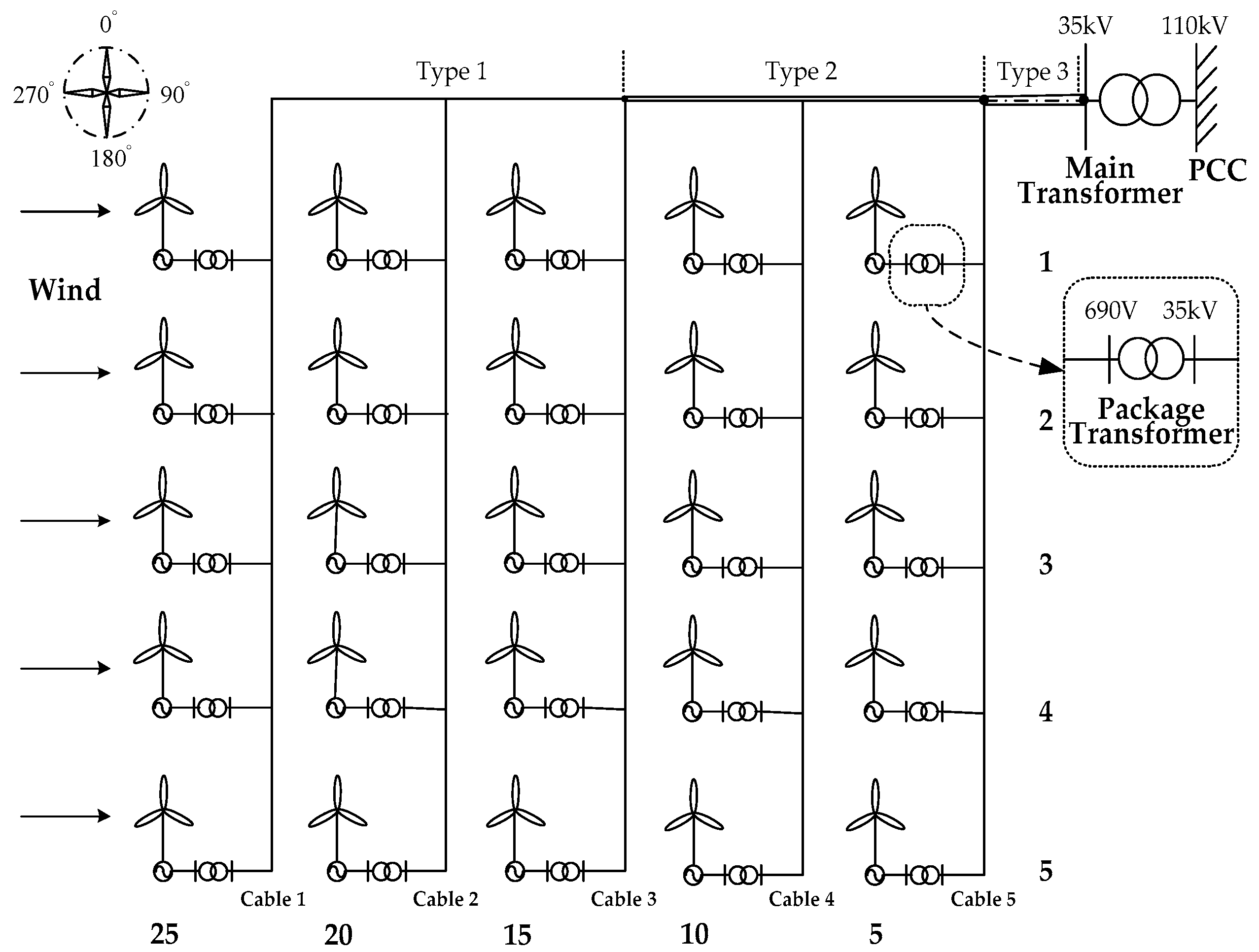
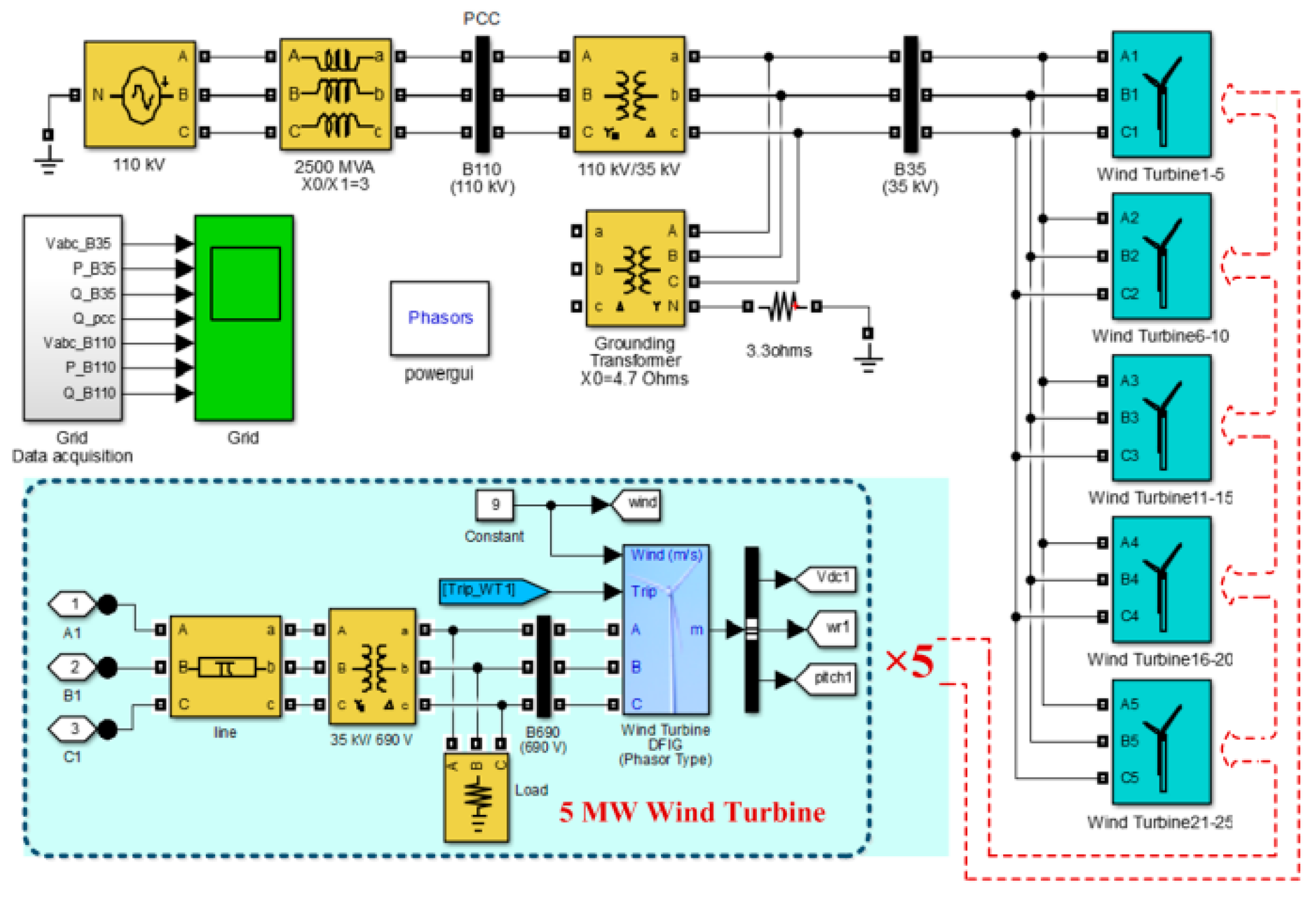




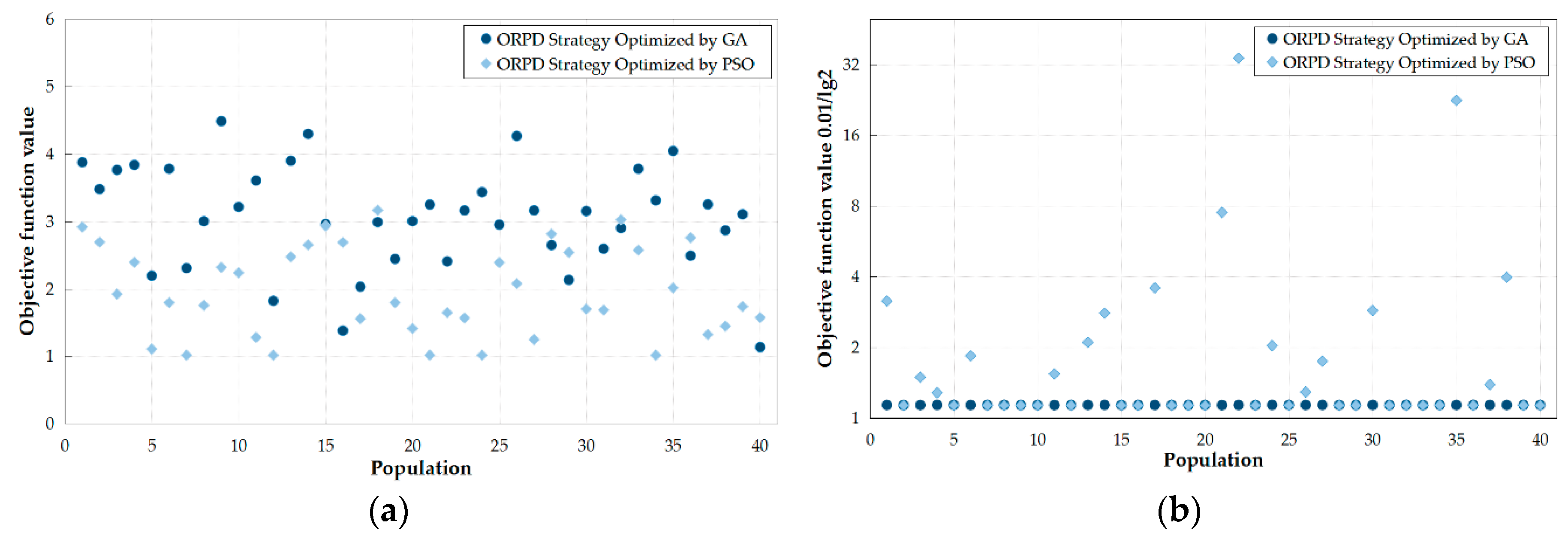
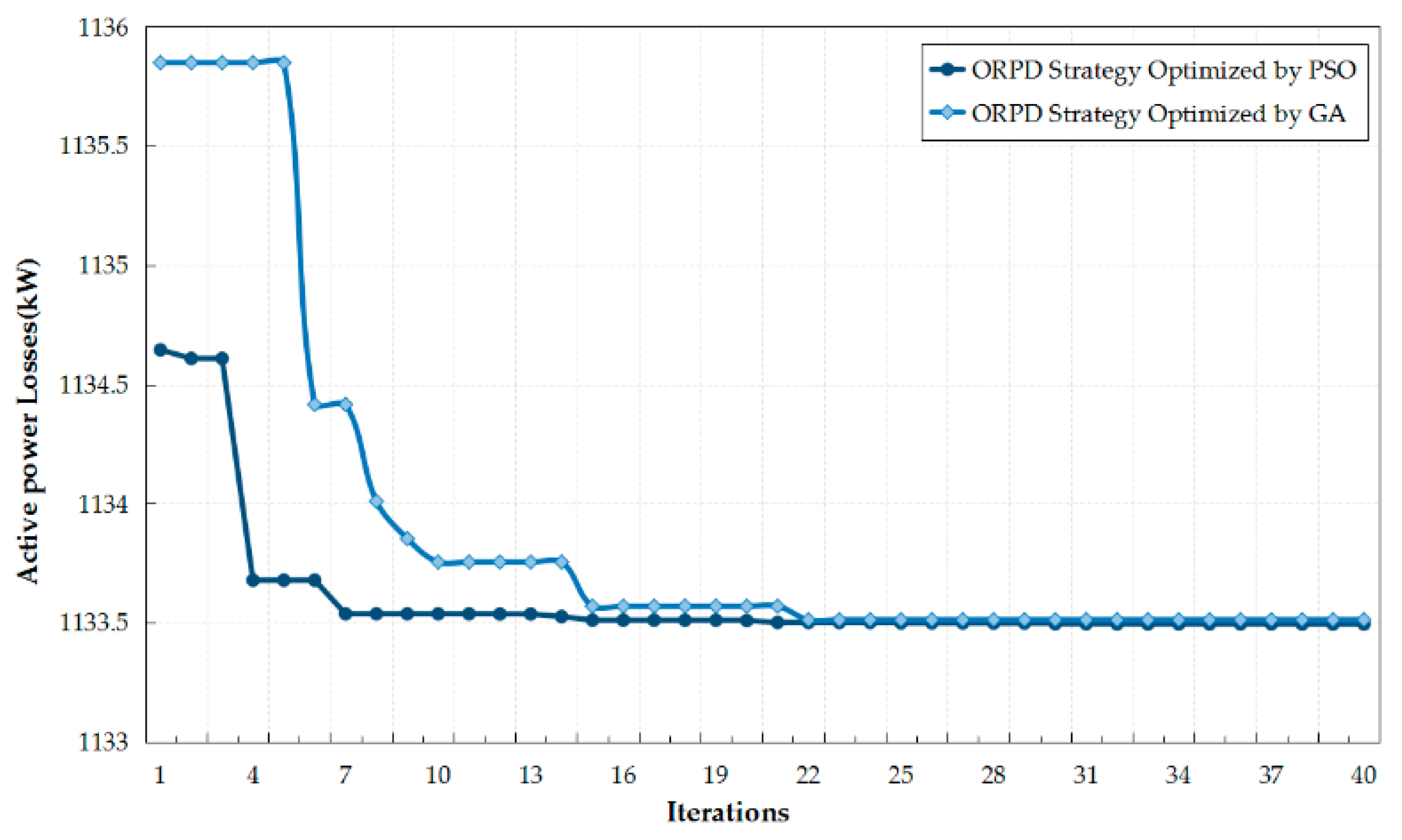
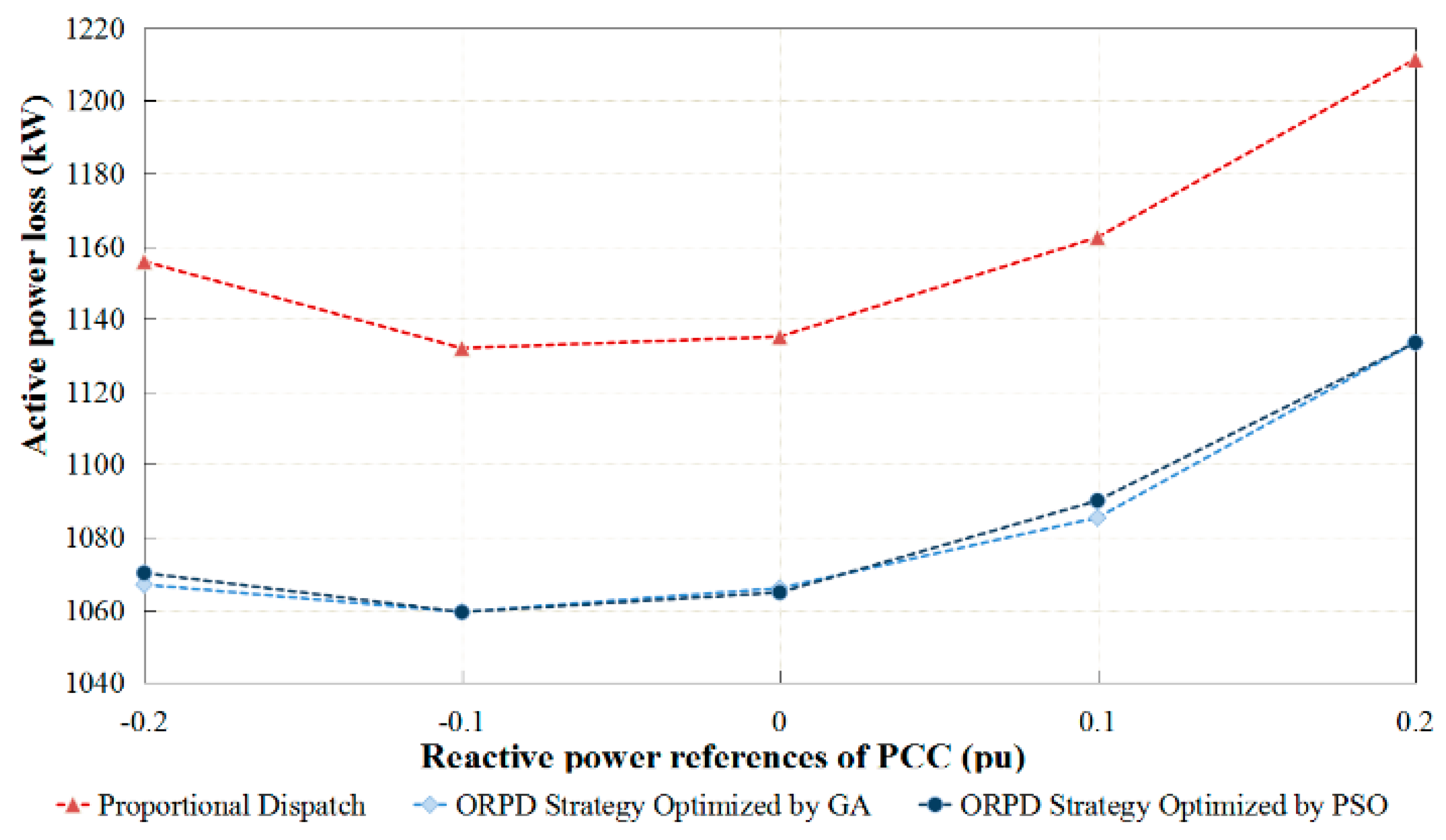
| Strategy of Dispatch | Proportional Dispatch | ORPD Strategy | ||
|---|---|---|---|---|
| WF Loss (kW) | Optimized by GA | Optimized by PSO | ||
| Cable + Package Transformers | 529.03 | 452.44 | 452.35 | |
| Main Transformer | 682.30 | 681.15 | 681.15 | |
| Total | 1211.34 | 1133.59 | 1133.49 | |
| Proportional Dispatch (GWh) | Proportion of Losses | ORPD Strategy | ||||
|---|---|---|---|---|---|---|
| GA (GWh) | Proportion of Losses | PSO (GWh) | Proportion of Losses | |||
| −0.2 | 9.57 | 2.12% | 8.81 | 1.94% | 8.86 | 1.96% |
| −0.1 | 9.37 | 2.07% | 8.7 | 1.92% | 8.74 | 1.93% |
| 0 | 9.37 | 2.07% | 8.74 | 1.93% | 8.77 | 1.93% |
| 0.1 | 9.58 | 2.12% | 8.91 | 1.97% | 8.94 | 1.97% |
| 0.2 | 9.9 | 2.21% | 9.18 | 2.04% | 9.22 | 2.06% |
| Annual Loss Reduction (GWh) | Standard Coal (t/year) | CO2 Emissions (t/year) | Carbon Emissions (t/year) | |
|---|---|---|---|---|
| −0.2 | 0.77 | 308 | 604.45 | 209.44 |
| −0.1 | 0.67 | 272 | 533.8 | 182.24 |
| 0 | 0.63 | 256 | 502.4 | 171.36 |
| 0.1 | 0.66 | 268 | 525.95 | 179.52 |
| 0.2 | 0.73 | 284 | 557.35 | 198.56 |
© 2018 by the authors. Licensee MDPI, Basel, Switzerland. This article is an open access article distributed under the terms and conditions of the Creative Commons Attribution (CC BY) license (http://creativecommons.org/licenses/by/4.0/).
Share and Cite
Xiao, Y.; Wang, Y.; Sun, Y. Reactive Power Optimal Control of a Wind Farm for Minimizing Collector System Losses. Energies 2018, 11, 3177. https://doi.org/10.3390/en11113177
Xiao Y, Wang Y, Sun Y. Reactive Power Optimal Control of a Wind Farm for Minimizing Collector System Losses. Energies. 2018; 11(11):3177. https://doi.org/10.3390/en11113177
Chicago/Turabian StyleXiao, Yunqi, Yi Wang, and Yanping Sun. 2018. "Reactive Power Optimal Control of a Wind Farm for Minimizing Collector System Losses" Energies 11, no. 11: 3177. https://doi.org/10.3390/en11113177





